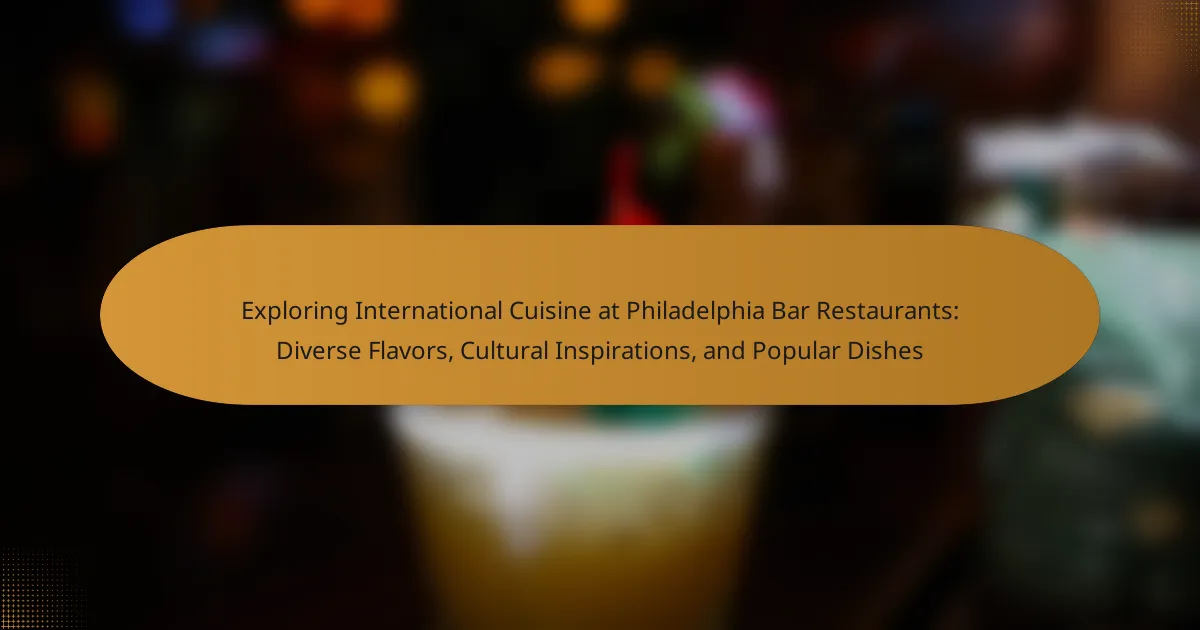
What is International Cuisine in Philadelphia Bar Restaurants?
International cuisine in Philadelphia bar restaurants refers to a variety of dishes and flavors from different cultures. These establishments offer a diverse menu that includes global influences. Popular examples include Mexican tacos, Italian pasta, and Asian stir-fries. Many bars incorporate local ingredients into these international dishes. This approach enhances the dining experience by blending traditional recipes with regional flavors. Philadelphia’s culinary scene is known for its creativity and fusion of tastes. The city’s multicultural population contributes to this rich diversity in bar menus. International cuisine in these venues reflects the city’s vibrant cultural fabric.
How is International Cuisine Defined in the Context of Bar Restaurants?
International cuisine in the context of bar restaurants refers to a variety of global dishes served in a casual dining atmosphere. Bar restaurants often blend traditional recipes with local ingredients. This creates unique flavor combinations that appeal to diverse clientele. The incorporation of international cuisine enhances the dining experience. It allows patrons to explore different cultures through food. Many bar restaurants feature menus inspired by Mediterranean, Asian, Latin American, and other global cuisines. This trend reflects the growing demand for diverse culinary options. Research shows that 70% of consumers enjoy trying new international foods when dining out.
What are the Key Characteristics of International Cuisine?
International cuisine is characterized by its diverse flavors and cultural influences. It incorporates various cooking techniques and ingredients from around the world. Each region contributes unique dishes that reflect local traditions. Spices and herbs play a significant role in flavoring international dishes. Presentation styles also vary, showcasing cultural aesthetics. Seasonal and regional ingredients are often prioritized for authenticity. Dietary restrictions and preferences are increasingly considered in modern international cuisine. Fusion cuisine blends elements from different culinary traditions, creating innovative dishes.
How Does International Cuisine Differ from Traditional Bar Food?
International cuisine features diverse, globally inspired dishes, while traditional bar food typically includes simple, familiar fare. International cuisine often uses unique ingredients and cooking techniques from various cultures. Examples include sushi, tapas, or curry, which reflect specific regional flavors. In contrast, traditional bar food usually consists of items like wings, nachos, or burgers, focusing on convenience and shareability. The preparation methods also differ; international dishes may involve intricate techniques and presentations. Traditional bar food prioritizes quick preparation for easy consumption in a social setting. This distinction highlights the broader variety and cultural significance found in international cuisine compared to the more straightforward offerings of traditional bar food.
What Cultural Influences Shape International Cuisine in Philadelphia?
Philadelphia’s international cuisine is shaped by diverse cultural influences. The city’s rich immigrant history contributes significantly to its culinary landscape. Communities from Italy, Mexico, Asia, and the Middle East have established their culinary traditions here. For example, Italian immigrants introduced iconic dishes like cheesesteaks and pizza. Mexican communities have popularized tacos and enchiladas, enhancing the local food scene. Asian influences bring flavors from Chinese, Vietnamese, and Indian cuisines, evident in local restaurants. Additionally, the city’s historical connections to various cultures foster a blend of flavors and techniques. Festivals and cultural events celebrate these culinary traditions, further enriching Philadelphia’s international cuisine.
Which Cultures are Most Represented in Philadelphia’s Bar Scene?
Philadelphia’s bar scene is most represented by Irish, Italian, and Mexican cultures. Irish pubs are a staple, offering traditional drinks and cuisine. Italian bars often feature wine and pasta dishes. Mexican establishments provide vibrant cocktails and authentic dishes. The diversity reflects the city’s rich immigrant history. Each culture contributes unique flavors and experiences. This blend makes Philadelphia’s bar scene dynamic and appealing.
How Do Local Ingredients Influence International Dishes?
Local ingredients significantly influence international dishes by adding unique flavors and cultural authenticity. The use of local produce reflects regional tastes and cooking traditions. For example, tomatoes in Italian cuisine or spices in Indian dishes showcase local agricultural products. This practice enhances the overall dining experience by offering freshness and seasonal variety. Historical trade routes also play a role in ingredient adaptation across cultures. Ingredients like chili peppers moved from the Americas to Asia, altering traditional recipes. Studies show that local sourcing can improve dish quality and customer satisfaction. Thus, local ingredients are essential in shaping the identity of international cuisine.

What Popular Dishes Can Be Found in Philadelphia Bar Restaurants?
Popular dishes found in Philadelphia bar restaurants include cheesesteaks, soft pretzels, and chicken wings. Cheesesteaks are iconic, featuring thinly sliced beef and melted cheese in a hoagie roll. Soft pretzels are a beloved snack, often served with mustard. Chicken wings are commonly offered, available in various sauces and styles. Other popular items include loaded fries and nachos, appealing to a wide range of tastes. These dishes reflect Philadelphia’s culinary heritage and are staples in local bar menus.
Which International Dishes are Favorites Among Locals?
Tacos are a favorite international dish among locals. They are popular for their versatility and flavor. Many Philadelphia bar restaurants serve authentic Mexican tacos. These dishes often include various fillings like beef, chicken, and vegetables. Pizza is another beloved international dish. It reflects Italian culinary traditions and is widely enjoyed. Many local bars offer unique toppings and styles. Sushi also ranks high among local favorites. It showcases Japanese cuisine and offers a fresh dining experience. Popular sushi rolls often include ingredients like avocado and spicy tuna. These dishes highlight the diverse culinary landscape in Philadelphia bar restaurants.
What Ingredients are Commonly Used in These Popular Dishes?
Common ingredients in popular dishes include rice, beans, and various spices. Rice serves as a staple in many cuisines, providing a base for dishes like paella and biryani. Beans add protein and fiber, commonly found in chili and tacos. Spices such as cumin, coriander, and paprika enhance flavors across different cultural dishes. Vegetables like tomatoes, onions, and peppers are frequently used for freshness and texture. Proteins such as chicken, beef, and seafood are prevalent in various recipes, contributing essential nutrients. Herbs like cilantro and basil often garnish dishes, adding aromatic qualities. Each ingredient plays a crucial role in defining the dish’s cultural identity and flavor profile.
How Do Bar Restaurants Put Their Own Spin on Classic Dishes?
Bar restaurants put their own spin on classic dishes by incorporating unique ingredients and innovative cooking techniques. They often blend traditional recipes with local flavors. This creates a fusion that appeals to diverse palates. For example, a bar might use craft beer in a batter for fish and chips. They may also introduce unexpected toppings or sauces to familiar favorites. Seasonal ingredients are frequently highlighted to enhance freshness. Additionally, bar restaurants often present dishes in creative ways to enhance visual appeal. This approach not only elevates the dining experience but also encourages culinary exploration.
What Unique Flavors Can Diners Expect from Philadelphia’s Bar Restaurants?
Diners can expect a variety of unique flavors from Philadelphia’s bar restaurants. These establishments often blend traditional American fare with international influences. Popular dishes include Korean BBQ tacos and Italian-inspired cheesesteaks. Many bars feature craft beer pairings that enhance the dining experience. Seasonal ingredients are frequently used to create fresh, innovative dishes. The city’s rich cultural diversity contributes to the unique flavor profiles found in these menus. For example, you might find Mediterranean mezze platters alongside classic pub burgers. This fusion of flavors reflects Philadelphia’s culinary evolution and local creativity.
How Do Flavor Profiles Vary Across Different Cuisines?
Flavor profiles vary significantly across different cuisines due to regional ingredients and cooking techniques. For example, Italian cuisine often features herbs like basil and oregano, emphasizing fresh, savory flavors. In contrast, Thai cuisine is known for its balance of sweet, sour, salty, and spicy elements, utilizing ingredients like lemongrass and fish sauce.
Mexican cuisine showcases bold flavors through the use of spices such as cumin and chili peppers. Japanese cuisine focuses on umami, achieved through ingredients like miso and soy sauce, providing a subtle depth of flavor. Indian cuisine is characterized by its complex spice blends, such as garam masala, which create rich, aromatic dishes.
The variation in flavor profiles is also influenced by cultural practices and historical trade routes. For instance, the introduction of spices from the Silk Road has shaped many Asian cuisines. Overall, the diversity in flavor profiles reflects the unique culinary heritage of each region.
What Role Does Fusion Cuisine Play in the Local Bar Scene?
Fusion cuisine enhances the local bar scene by offering innovative food pairings that attract diverse clientele. Bars that incorporate fusion cuisine create unique dining experiences. These establishments often blend flavors from different cultures, appealing to adventurous eaters. For example, a bar may serve Korean tacos or sushi rolls with a twist. This culinary approach encourages social sharing and enhances the overall atmosphere. Furthermore, fusion dishes can complement craft cocktails, boosting drink sales. According to a 2021 survey, 70% of patrons enjoy trying new flavors when dining out. This trend indicates a growing demand for creative fusion options in bars.

How Can Diners Explore International Cuisine at Philadelphia Bar Restaurants?
Diners can explore international cuisine at Philadelphia bar restaurants by sampling diverse menus that feature global dishes. Many bars incorporate flavors from various cultures, offering options like tacos, sushi, and curry. The presence of food trucks and pop-up events enhances this experience, showcasing culinary diversity. Diners can also participate in themed nights that focus on specific cuisines, such as Italian or Mexican. Additionally, many establishments provide tasting flights or small plates, allowing patrons to try multiple dishes. Philadelphia’s vibrant food scene is reflected in its bar offerings, making it easy to discover new flavors. Engaging with chefs and staff can provide insights into the cultural significance of the dishes served.
What Tips Can Enhance the Experience of Trying International Dishes?
To enhance the experience of trying international dishes, approach the tasting with an open mind. Familiarize yourself with the cultural background of the cuisine. Understanding the origins can deepen appreciation. Engage with the staff for recommendations and insights. They often have valuable knowledge about the dishes. Consider sharing plates to sample multiple flavors. This allows for a broader experience of the menu. Pair dishes with appropriate beverages to complement the flavors. Research the traditional dining etiquette of the cuisine. This can enrich the overall experience. Lastly, take notes on what you enjoy for future reference.
How Can Diners Pair Drinks with International Cuisine?
Diners can pair drinks with international cuisine by considering complementary flavors. For example, spicy dishes from Thai cuisine pair well with sweet wines like Riesling. Rich, fatty foods like duck can be balanced with a light, crisp beer. Italian pasta dishes often match nicely with Chianti or other red wines. Fresh seafood from Japanese cuisine is enhanced by sake or light white wines.
Research indicates that flavor profiles influence drink pairings significantly. According to a study published in the Journal of Food Science, matching acidity and sweetness levels between food and beverages enhances the dining experience. Therefore, understanding the primary flavors of a dish aids in selecting the right drink.
What Should Diners Know About Dietary Restrictions in International Dishes?
Diners should know that international dishes often contain ingredients that may conflict with dietary restrictions. Common allergens like gluten, nuts, and dairy are prevalent in many cuisines. For example, Asian dishes frequently include soy sauce, which contains gluten. Mediterranean cuisine often features dairy products like feta cheese. Diners with specific dietary needs should inquire about ingredients before ordering. Many restaurants are becoming more accommodating to dietary restrictions. They may offer substitutions or modifications for popular dishes. Understanding these factors can enhance the dining experience and ensure safety.
What Are the Best Practices for Enjoying International Cuisine in a Bar Setting?
To enjoy international cuisine in a bar setting, select dishes that are easy to share. Tapas or small plates work well for this purpose. Pair your food choices with suitable beverages, enhancing the overall experience. Engage with the staff for recommendations on popular items. Consider dietary restrictions when ordering to ensure everyone can enjoy the meal. Enjoy the ambiance, as it can elevate the dining experience. Lastly, be open to trying new flavors and cuisines, which enriches the culinary adventure. These practices enhance the enjoyment of international cuisine in a bar environment.
The main entity of this article is international cuisine in Philadelphia bar restaurants. The article provides an overview of the diverse dishes and flavors that reflect various cultural influences, highlighting popular items such as tacos, sushi, and cheesesteaks. It explores the key characteristics of international cuisine, how it differs from traditional bar food, and the impact of local ingredients on flavor profiles. Additionally, the article discusses the representation of different cultures in Philadelphia’s bar scene and offers tips for diners to enhance their experience while exploring these culinary offerings.




